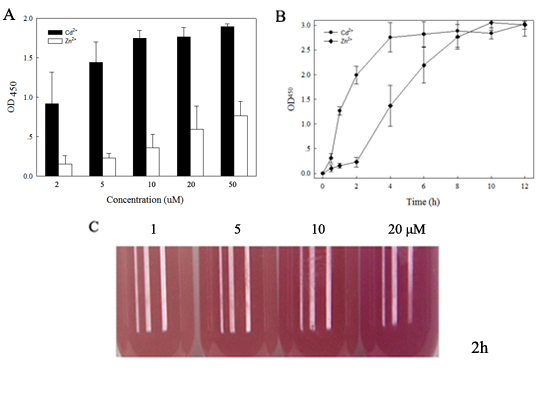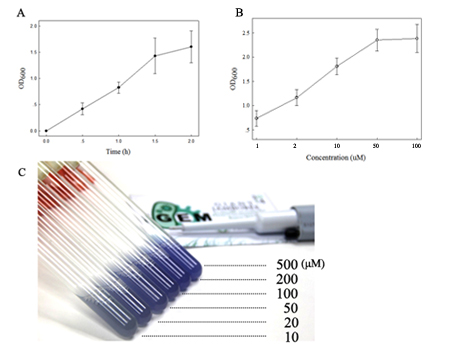Part:BBa_K1509000
Coding for the trans-acting regulator SmtB
In 1993, Huckle and co-workers reported the isolation and analysis of the smt locus from Synechococcus elongates PCC7942. Gene smtB, one of the components of the locus, encodes a transcriptional repressor of gene smtA, with which is required for normal tolerance to Zn2+ and Cd2+. The product of smtB functions by binding to the smt operator-promoter(smtO-P) and dissociating in the presence of Zn2+. There are four potential metal binding sites on protein SmtB as known as α3, α3N, α5 and α5C. Different from Zn2+ resistance mechanisms, Cd2+ binds SmtB at the site α3N . These two mechanisms both cause the elevated expression of smtA.
Usage and Biology
In our project, we wanted to use pigments as reporters in our designed genetic construction which can be recognizable by the naked eyes. According to the previous work, we have chosen an identified pigment in the Registry: the biobrick of amilCP (BBa_K592009) was used as reporter gene in our metal detection device. After exchanging the biobrick part with smtA in smtB-OP-smtA device, the pigment gene was under control of metal-induced promoter (smtB-OP).

Result
In summary, the Rosetta-plysS strain made our system convenient to be applied, the classical smtB-OP-smtA device from Staphylococcus supported our system a responsive Cd2+ inducible-promoter, and the viewable pigment gene provided our system a reliable and macroscopic observation. After theoretical prediction, genetic engineering, experimental optimization and reasonable model analysis (deeply discussed in Modeling), our detecting system residing in the engineering bacteria was able to sensitively represent the content of Cd2+ (1-100μM) in 1-2 hours.
Although the inducible operator in our case might also response to other metal ions including Zn2+, our date at least did point out that Cd2+ has acuter stimulus to the pigment gene than Zn2+ which was confirmed both from experimental data and model analysis. We achieved to our goal at a certain degree. Finally, our system is easier to utilize and exhibits improved flexibility as a tool to detect Cd2+ which belongs to the toxical heavy metal ions.
fig.1. Growth of cells containing smtB-OP-smtA element in LB medium supplemented with 2μM Cd2+. Cells were inoculated at a density of 1x106 cells ml-1, and growth was monitored by measuring the OD540 value. Data points represent the mean values from three separate cultures with SD.
fig.2. A. Metal-induced expression of the pigments (RFP), Rosetta-plysS (1x106 cells ml-1) carrying the smtB-OP-RFP element were grown with Cd2+ and Zn2+ (1-50μM) supplement for 2h immediately before assay and expression was monitored by measuring the OD450 value; B. Metal-induced expression of the pigments (RFP). Rosetta-plysS carrying the smtB-OP-RFP element were grown with Cd2+ and Zn2+ (2μM) supplement for 1-12h immediately before measurement; C. Cadmium-induced expression of the pigment (RFP) at different concentrations. Rosetta-plysS (1x107 cells ml-1) carrying the smtB-OP-RFP element were grown with Cd2+ (1-20μM) supplement for 2h. The data points shown in A and B represent the means of three separate assays with SD.
fig.3. A. Cadmium-induced expression of the pigment (amilCP) at constant concentration. Rosetta-plysS (1x106 cells ml-1) carrying the smtB-OP-amilCP element were grown with Cd2+ (1μM) supplement for 1-2h immediately before assay and the expression was monitored by measuring the OD600 value; B. Cadmium-induced expression of the pigment (amilCP) with different concentrations. Rosetta-plysS carrying the smtB-OP-amilCP device were grown with Cd2+ (1-100μM) supplement for 1h immediately before assay;C. Cadmium-induced expression of the pigment (amilCP) with different concentrations. Rosetta-plysS (1x107 cells ml-1) carrying the smtB-OP-amilCP element were grown with Cd2+ (10, 20, 50, 100, 200 and 500 μM) supplement for 2h. The data points shown in A and B represent the means of three separate values with SD.
Sequence and Features
- 10INCOMPATIBLE WITH RFC[10]Illegal PstI site found at 349
- 12INCOMPATIBLE WITH RFC[12]Illegal NheI site found at 260
Illegal PstI site found at 349 - 21COMPATIBLE WITH RFC[21]
- 23INCOMPATIBLE WITH RFC[23]Illegal PstI site found at 349
- 25INCOMPATIBLE WITH RFC[25]Illegal PstI site found at 349
- 1000COMPATIBLE WITH RFC[1000]
//cds/transcriptionalregulator/repressor
| None |



